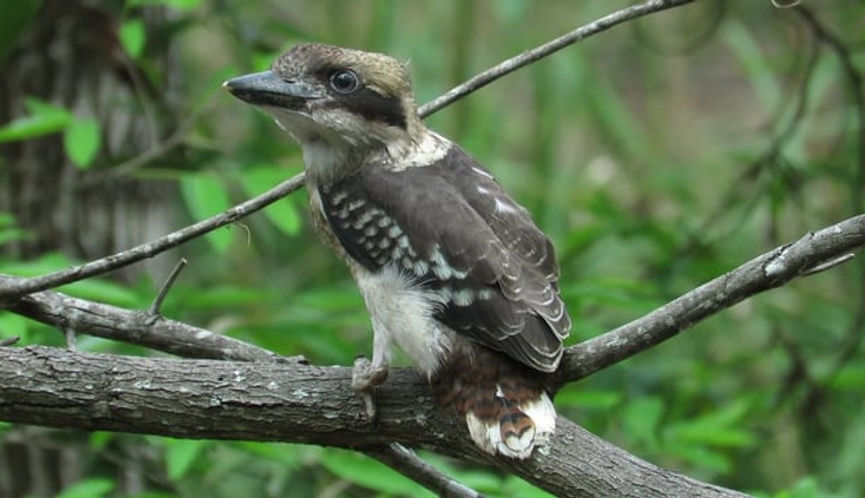Laughing Kookaburra
Dacelo novaeguineae
Quick facts
Other names: Laughing Jackass, Bushman’s Clock, Giant Kingfisher.
Size: Similar to Feral Pigeon.
Range and lifestyle: Eastern Australia
Food: Mainly insects, spiders, millipedes, and lizards, but also occasionally worms, snails, small birds, frogs and snakes.
Breeding: Mostly September to December. Nest is hole in tree or termite mound. Eggs, usually three, white. Mum, dad and any helpers incubate the 3 (usually) white eggs for about 4 weeks, and feed the chicks in the nest for another 5 weeks.
Probably the most famous of Australia’s birds around the world, the Laughing Kookaburra is best known for its unmistakable raucous laughing call, which could frequently be heard in old African jungle movies like Tarzan. But the kookaburra is unique to Australia, and its name comes from the Wiradhuri language of Aboriginal clans living in western New South Wales. The kookaburra features in many Aboriginal dreaming stories about their habit of calling before sunrise. Because of this dawn chorus, kookaburras were often called the “Bushman’s Clock” or “Alarm Bird” by the early white settlers. The species soon became a national icon, figured on military badges, coins, matches, tea, and its name was used for a navy ship and even a cooking stove, cleverly called the Early Kooka. And who doesn’t know the jingle “Kookaburra sits in the old gum tree”?
The Laughing Kookaburra, one of four kookaburra species, is the largest member of the kingfisher family, but like most kingfisher species it very rarely eats fish (see quick facts). Kookaburras are ‘sit-and-wait’ predators, remaining motionless on a perch for long periods, until their sharp eyes detect the movement of an invertebrate or lizard on the ground, and they pounce! Although Kookaburras only occasionally catch and eat snakes, this ability was exaggerated last century and resulted in some short-sighted people introducing them to Western Australia and Tasmania, where they did not occur naturally, in the vain expectation that they would control snakes. Small prey is swallowed whole, but larger prey is killed by bashing it against the ground or a branch.
Unusually for birds, female kookaburras are larger and heavier than males, but it is difficult to distinguish them by their appearance. Males usually have a blue rump, while that of females is usually brown, but there are many exceptions.
Kookaburras are social, living in pairs or groups of three to nine birds, composed of a dominant breeding pair and one or more of their children, who help their parents to raise more babies – a system called cooperative breeding. The breeding pair stay together for many years until one or both die (10-15 years). Young females usually leave their home territory after a year, while males often leave after two years.
All members of the group incubate the eggs and feed the babies, but the dominant male does most of the incubation during the day, while the dominant female usually incubates during the night. Dominant males also feed the babies the most, and female helpers the least. Amazingly the breeding female is able to control whether her eggs will be male or female. In groups with helpers that are all male, most of the female’s eggs will turn into daughters, but if all the helpers in the group are female, most of the eggs will turn into sons, probably because they are better at feeding babies.
Text © Richard Noske 2019 CC BY-NC-SA




















